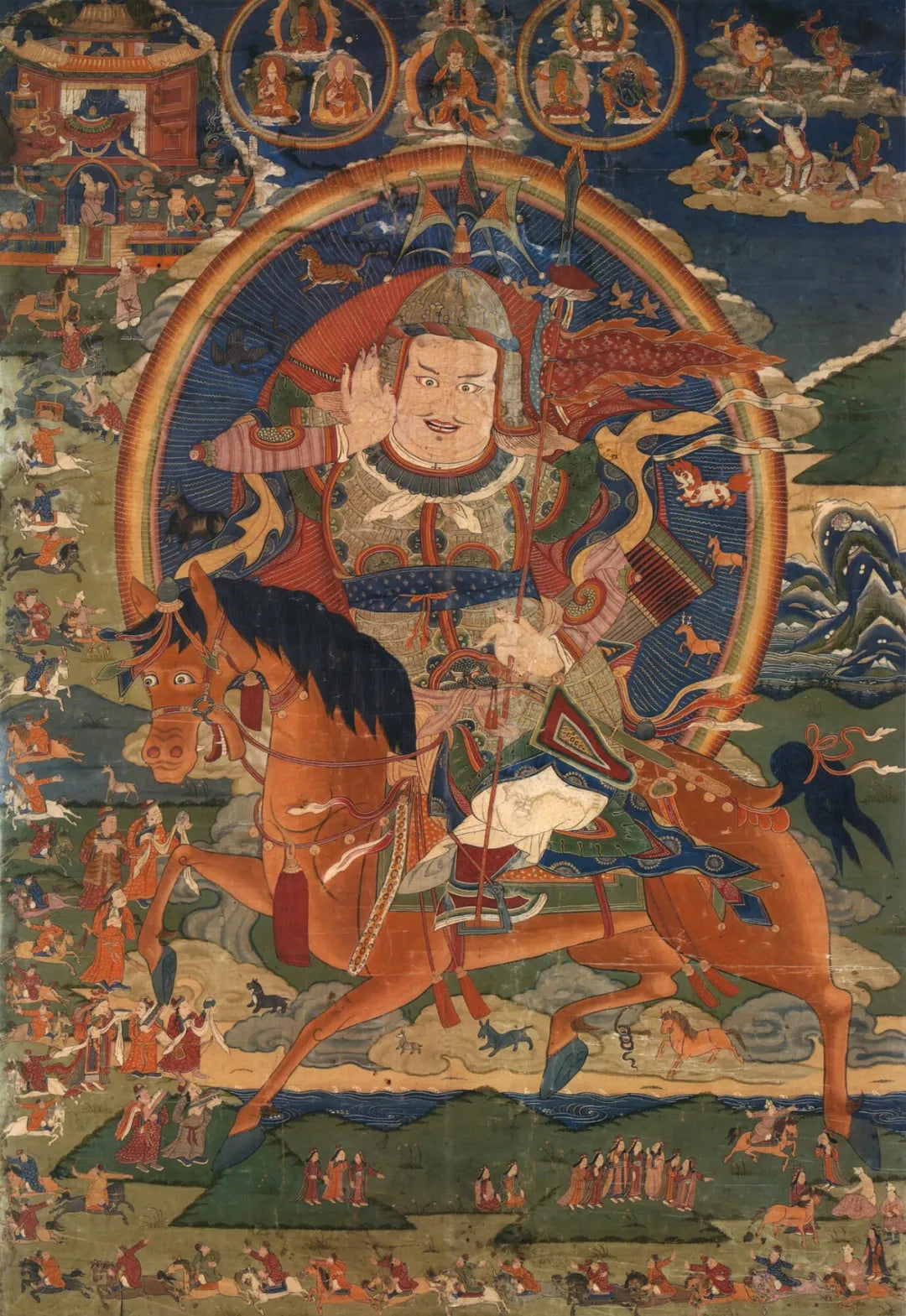
Soul Sound ▎Opera Protagonist King Gesar

"King Gesar: Norbu Dradul / The Jewel that Repels Enemies"
Second half of the 19th century, NYTH Museum.

"Peter Lieberson"
Filmed in 1981, Schirmer Archives
(G. Schirmer Archives)
The white smoke of the juniper
rises Fragrant and dense from the burning coals,
Billowing into an empty shining sky,
A vast mirror-like expanse Unclouded by the shadow
or birth or fear of death.
Excerpted from *"Lieberson: King Gesar"* Opera Libretto
By writer and scholar Douglas Penick
(Douglas Penick)
Partial content translated from original passages of the epic text.

*"Lieberson: King Gesar"*
1996 Edition, Released by Sony Classical
The cover features the Tibetan characters ཀི་ and བསྭོ་ to emphasize the power of King Gesar,
Both selected from the calligraphy of Chögyam Trungpa (1939-1987).

*"Lieberson: King Gesar"* Score Interior
Music by Lieberson, Libretto by Penick
Published by G. Schirmer, Inc., 1991–1992
In 2011, after enduring a long battle with illness, Peter Lieberson (1946–2011) passed away at the age of 64. Even in the final stages of his life, this graceful and approachable gentleman continually reminded his friends and family not to forget the hidden wisdom and the unique heritage of Tibet. Obituaries and memorial articles flooded mainstream media at the time, with colleagues who had worked alongside Lieberson praising his musical achievements. Among them were conductor Seiji Ozawa, cellist Yo-Yo Ma, minimalist composer Philip Glass, as well as pianists Emanuel Ax and Peter Serkin, both of whom had long-standing collaborations with Lieberson.
As one of the most important composers of the post-World War II era, Peter Lieberson seamlessly integrated his identity as a practitioner into his daily musical creations and lifestyle. People often spoke fondly of his teacher-student relationship with Chögyam Trungpa. Those who studied with or were mentored by Lieberson (he was one of the earliest teachers of the Shambhala Training program) described him as someone who "truly understood and believed in Chögyam Trungpa," calling him an "outstanding student, a role model for others, and a gentle administrator." Before meeting Chögyam Trungpa, Lieberson, who came from a musical family and had studied under many renowned masters, found himself lost in a "labyrinth of theory": proficient in traditional compositional techniques but having forgotten why he composed, losing the ability to express himself.
How to make people perceive the world through music, and how to use music to build a platform based on universal values, were the ultimate goals Lieberson pursued. In 1976, the bewildered composer met Chögyam Trungpa, and these challenges were resolved. Chögyam Trungpa continually advised him, "Structure is not a constraint; it reveals the root of the complex situations in which all things exist, namely, the self-centered perspective." This perspective makes people rely on the layering of concepts rather than facing experiences and feelings directly. During his decade of following Chögyam Trungpa, Lieberson abandoned a certain determinist viewpoint: that listeners should be overwhelmed by music. Instead, he focused on the "soul sound," rediscovering the wisdom of experience and feeling within concepts.

*"Lieberson Teaching at the Lake Louise Vajradhatu Seminary"*
Photographed by Marvin Moore in 1981.

*"Drala / Warrior Deity / Drala"* Score Interior
(A Large-Scale Orchestral Work)
Published by G. Schirmer, Inc., 1986.

*"Drala / Warrior Deity"*
Mid-19th Century, Eastern Origin, Private Collection.

*"The Six Realms"* Score Interior
(A Cello Concerto)
Published by G. Schirmer, Inc., 2000.

*"The Treasury of Revelations: Tsakali of the Six Buddhas and Six Sages"*
Late 19th Century, Shechen Archives.
From *"Drala / Warrior Deity"* (1986) to *"King Gesar"* (1992), from *"The Five Great Elements"* (1995) to *"Red Garuda"* (1999), and culminating in *"The Six Realms"* (2000), Lieberson continually explored the unique musical value of Tibetan culture. "These concepts, familiar on the high plateau, transcend ethnic and cultural divides, offering us profound inspiration." Drala, associated with individual energy; the Five Elements, embodying the essence of harmony; the Garuda, symbolizing the nature of the self; and the Six Realms, representing impermanence—all these concepts, in Lieberson's creative vision, help us recall our commitment to the world and ourselves: to treat one another with fearlessness and compassion, and to believe in light amidst chaos.
"For me, King Gesar is not merely a historical figure or a legendary hero; he is the ultimate symbol of the path to enlightenment." In Lieberson's musical works, the name and related concepts of King Gesar frequently appear (influenced by Chögyam Trungpa). In the chamber opera *"King Gesar,"* Lieberson and Douglas Penick divided the hero's life into seven sections: Invocation, Birth, Trials, Horse Race, Goddess's Song, Subjugation of Demons, and Song of Fulfillment. While preserving the characteristics of traditional storytelling, Lieberson employed highly experimental structural treatments. Unprepared listeners are drawn into a parallel space filled with infinite possibilities, experiencing the story from the hero's perspective, the gods' perspective, and sometimes even the enemy's perspective. Voices and instruments produce multiple tones simultaneously, with vocal intentions and melodic meanings deliberately obscured. The rhythm is highly repetitive yet includes deviations and subtle variations. In this context, the auditory interpretation of the work is entirely up to the listener, "each person profoundly realizing that they themselves are the hero Gesar."
I first encountered Lieberson's works in 2007, and nighttime is the best time to appreciate them. As the melodies flow, scenes shift, and the spirit of enlightenment subtly enters the heart. As a close friend of Lieberson wrote in his memory: "Like the fabric of life, warp and weft unique, precious threads weave a noble heart; no longer remembering the desert, the soul has risen to the sea."

*"King Gesar: Norbu Dradul / The Jewel that Repels Enemies"*
(Including a Specific Narrative)
Early 20th Century, Hahn Cultural Foundation.
